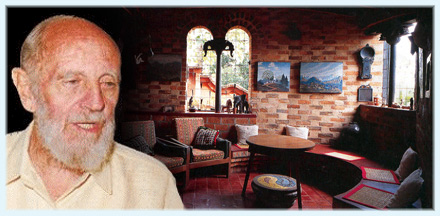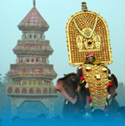Kerala Houses Architecture
The traditional houses of Keralities are built in accordance with the principles of 'Thatchushastra', the science of carpentry and 'Vaastushastra' the ancient Indian science of architecture.

|
Laurence Wilfred "Laurie" Baker (March 2, 1917 - April 1, 2007) was an award-winning English architect, renowned for his initiatives in low-cost housing. He went to India in 1945 in part as a missionary and since then lived and worked in India for over 50 years. He obtained Indian citizenship in 1989 and resided in Thiruvananthapuram (Trivandrum), Kerala.
Photo shows the inside of the Hamlet at Nalanchira near Thiruvananthapuram, which was home to Baker since 1970. |
Vasco House
This 16th century structure was supposedly the residence of the Portuguese sailor, Vasco da gama. It is located inside the Fort Kochi in Ernakulam. Highlight of the house include European glass paned windows and Balcony cum Verandas.
Thakur House
Originally the residence of the managers of National Bank of India during the British era, the Thakur House today is possessed by a respectable tea company. The house is a standing reminder of the architecture of the colonial era. The house was earlier known as Kunal or Hill Bungalow.
Pierce Leslie Bungalow
This 19th century bungalow initially belonged to Pierce Leslie & Co., the famous coffee merchants. The structure is a classic example of a combination of an architecture that is a mix of Portuguese, Dutch and local influences. The highlights of the house are wood panel roof of the ground floor, arched doorways, carved doors and spacious rooms. Water front verandas are also interesting to roam around.
Koder House
Named after its constructor, Samuel. S. Koder of the Cochin Electric Company, the Koder House was built in the year 1808 AD. The House is located in the Ernakulam district and is a wonderful example of the change of architectural style - from colonial to Indo-European architecture. The chess board pattern of floor, the red brick facade and the wooden bridge that joins the house to other structures across the street are some of the quiet interesting aspects of the house
Bishop's House
Constructed in the early 16th century, the Bishop's House served as the residence of the Portuguese Governor. It is perched over a small hillock and is marked by typical Gothic arches. Additionally, the circular garden path that leads upto the main entrance is another attraction. It was earlier known by the name of Dome Jos Gomes Ferreira who was the 27th Bishop of the Diocese of Cochin.
Bastion's Bungalow
This one is the official residence of the sub collector of Ernakulam. It was built in the middle of the 17th century and depicts the Indo European style of architecture. The name of the Bungalow is drawn from the site where it stands - the Stromberg Bastion of the old Dutch fort. This bungalow is believed to have secret tunnel, however, till date none of them has been discovered.
Gundert Bungalow
Gundert Bungalow was the residence of Dr. Hermann Gundert, a scholar who successfully compiled the first Malayalam dictionary, from 1839-59. Also, it was in this bungalow that Malayalam's oldest newspaper 'Paschimodayam' (also published by Gundert), developed. The bungalow is a typical colonial mansion with deep eaves, wide verandah and huge doors. Today, a technical training institute is being run in the Gundert Bungalow.
Mannadi
This is a memorial of the erstwhile diwan of the Travancore state, Veluthampi Dalawa, who gave up his life fighting for the freedom of his land against the mighty Britishers. The memorial, today reminds the visitors of the great courage shown by the diwan in face of extreme pressure.
Chittur Garumadam
This is yet another memorial that remembers a highly revered poet saint, Thunchath Ezhuthachan. He authored the well known 'Adhyatma Ramayana'. Thunchath Ezhuthachan is also credited for translating Mahabharata into Malayalam. The Garumadam displays items like a 'srichakra', some of the idols worshipped by him, wooden slippers used by him and a few old manuscripts are exhibited here. The day of Vijaydashmi sees hundreds of children being brought to the Gramudom for a ritualistic initiation of learning. The Gramodam is located on the banks of Solkanasini river (destroyer of sorrows) in the Pallakad district of Kerala.
This article is licensed under the GNU Free Documentation License. It uses material from the Wikipedia and numerous other sources that provide freedom to copy and redistribute content, with or without modifying it, either commercially or noncommercially. |







